Tenerife is the largest of the Canary Islands and is a great place to travel. British, Nordic and German tourists come in their tens of thousands every year to visit its spectacular beaches and lively nightlife. It is also very popular among holidaymakers from the Spanish peninsula, especially during Easter time. It offers lush forests, exotic fauna and flora, deserts, mountains, volcanoes, incredibly beautiful coastlines and spectacular beaches.
The entire island is a Spanish province named Santa Cruz de Tenerife, which leads to inevitable confusion with the capital city Santa Cruz de Tenerife. The island is divided into 31 municipalities, belonging to three regions with their own distinct climate, history, and appeal.
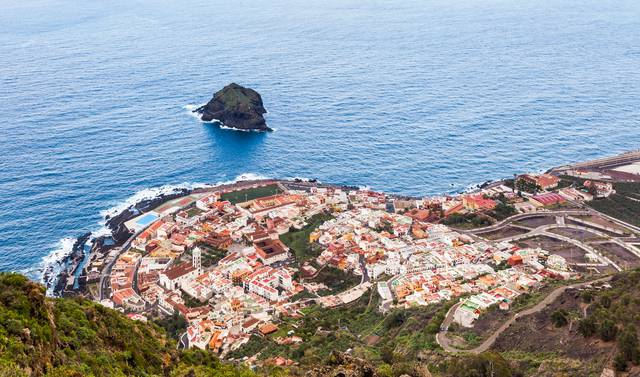
- Santa Cruz de Tenerife. — the capital
- La Esperanza. — town, in El Rosario municipality, founded by Castillian conquerors
- San Andrés. — one of the oldest settlements of Tenerife with a large white sand beach
- San Cristóbal de La Laguna. – a
- Taganana. — traditional town in the Anaga Rural Park with a rich tradition in sugar cane and wine cultivation
- Tegueste. — Guanche era colonial town, famous for its wines
Santa Cruz de Tenerife. — the capital
La Esperanza. — town, in El Rosario municipality, founded by Castillian conquerors
San Andrés. — one of the oldest settlements of Tenerife with a large white sand beach
San Cristóbal de La Laguna. – a
Taganana. — traditional town in the Anaga Rural Park with a rich tradition in sugar cane and wine cultivation
Tegueste. — Guanche era colonial town, famous for its wines
- El Sauzal. — town surrounded by rolling hills with vineyards
- Garachico. – a harbour city, partially destroyed and rebuilt after a volcanic eruption in the 18th century
- Icod de los Vinos. — famous for its millenary Drago tree, local wines, and the largest volcanic cave in Europe
- La Orotava. – a stately, beautiful city
- Puerto de la Cruz. – a laid-back, more family-friendly resort with the Loro Parque Zoo
El Sauzal. — town surrounded by rolling hills with vineyards
Garachico. – a harbour city, partially destroyed and rebuilt after a volcanic eruption in the 18th century
Icod de los Vinos. — famous for its [[Icod de los Vinos#Q5814115|millenary Drago tree]], local wines, and the largest volcanic cave in Europe
La Orotava. – a stately, beautiful city
Puerto de la Cruz. – a laid-back, more family-friendly resort with the Loro Parque Zoo
- Candelaria. — known for its basilica and pilgrimage
- Adeje. and Costa Adeje - Adeje/Americas/Cristianos is the most popular tourist resort with beaches
- El Medáno. – a laid back, alternative haven, and one of the windsurfing capitals of the world
- Granadilla de Abona. — former Guanche kingdom and home to the best restaurant of Tenerife
- Güímar. — town known for its lava rock pyramids and badlands
- Los Cristianos. - Adeje/Americas/Cristianos is the most popular tourist resort with beaches
- Los Gigantes. – popular with tourists and locals
- Masca. — picturesque mountain village in the Teno Massif
- Playa de las Américas. – with Los Cristianos and Costa Adeje, a city built for tourists with beaches
- Santiago del Teide. — desert town straddled between Teide National Park and the Teno massif
- Vilaflor.
Candelaria. — known for its basilica and pilgrimage
Adeje. and [[Costa Adeje]] - Adeje/Americas/Cristianos is the most popular tourist resort with beaches
El Medáno. – a laid back, alternative haven, and one of the windsurfing capitals of the world
Granadilla de Abona. — former Guanche kingdom and home to the best restaurant of Tenerife
Güímar. — town known for its [[Güímar#Q619588|lava rock pyramids]] and [[Güímar#Q3384707|badlands]]
Los Cristianos. - Adeje/Americas/Cristianos is the most popular tourist resort with beaches
Los Gigantes. – popular with tourists and locals
Masca. — picturesque mountain village in the Teno Massif
Playa de las Américas. – with Los Cristianos and Costa Adeje, a city built for tourists with beaches
Santiago del Teide. — desert town straddled between [[Teide National Park]] and the Teno massif
Vilaflor.
- Teide National Park. — a surrounding El Teide, with 3718 m the highest peak on Spanish territory, an active volcano, and most visited natural wonder in the country with over 4 million visitors in 2016.
- Anaga Rural Park. — or Macizo de Anaga protected area redesignated from natural park to rural park.
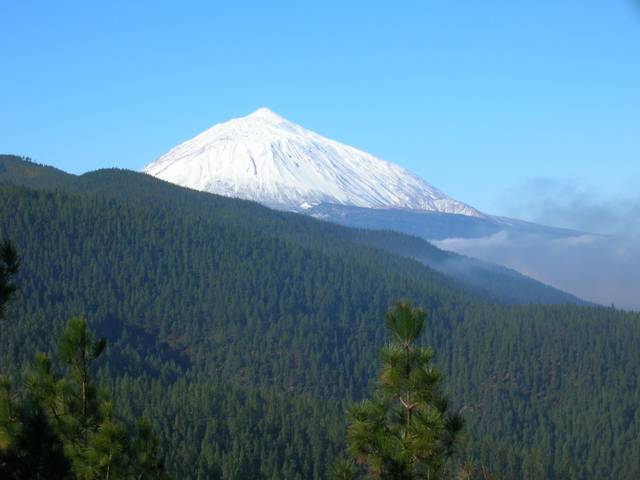
- Corona Forestal Natural Park. — Protected environmental zone with an area of 410 km², making it the largest protected natural area of the Canary Islands. It extends from ca. 300 m above sea level to the slope of Mount Guajara. at 2718 m. Most of the area is covered by Canarian pine forests.
- Teno Rural Park. — One of the 3 volcanic formations that make up Tenerife, in the northwestern part of the island. The massif is 5 to 7 million years old and furrowed by deep ravines. It ends abruptly in a series of high cliffs that plummet over the sea known as Los Gigantes. The park spans an area of 80 km² and is known for its basaltic lava flows and diverse flora resulting from its microclimate.
Teide National Park. — a surrounding El Teide, with 3718 m the highest peak on [[Spain|Spanish]] territory, an active volcano, and most visited natural wonder in the country with over 4 million visitors in 2016.
Anaga Rural Park. — or Macizo de Anaga protected area redesignated from natural park to rural park.
Corona Forestal Natural Park. — Protected environmental zone with an area of 410 km², making it the largest protected natural area of the [[Canary Islands]]. It extends from ca. 300 m above sea level to the slope of Mount Guajara. at 2718 m. Most of the area is covered by Canarian pine forests.
Corona Forestal Natural Park. — Protected environmental zone with an area of 410 km², making it the largest protected natural area of the [[Canary Islands]]. It extends from ca. 300 m above sea level to the slope of Mount Guajara. at 2718 m. Most of the area is covered by Canarian pine forests.
Teno Rural Park. — One of the 3 volcanic formations that make up Tenerife, in the northwestern part of the island. The massif is 5 to 7 million years old and furrowed by deep ravines. It ends abruptly in a series of high cliffs that plummet over the sea known as [[Los Gigantes]]. The park spans an area of 80 km² and is known for its basaltic lava flows and diverse flora resulting from its microclimate.
A poor, banana-growing region in past decades, Tenerife has been brought up to European living standards since the arrival of mass air travel in the 1960s, which brought industry and millions of tourists each year. Over the decades this has led to many complexes and houses being built, making parts of the island highly urbanized. While part of the EU for political purposes, the island remains outside its customs and VAT area, making high tax goods such as tobacco and alcohol cheaper than elsewhere in Europe. Because almost all goods must be imported, food and clothing in particular are more expensive than on mainland Europe.
Many of the young tourists hang out on the south of the island with older and family tourists choosing Puerto de La Cruz and its environs. On the south side there is consistent summer, little to no wind, and pretty much perfect beach-weather for much of the year though there have been rare instances of cool to cold weather in the Jan-Feb period. Also expect some very wet days for that time of year though most days will still be sunny. There are plenty of hotels, activities and British food and drink.
On the north side of the island you will find more green and vibrant local culture. There is a more Spanish year-round springtime feel. The weather fluctuates a bit more here, but is also mostly pleasant though not as hot as the south.
In between the north and south of the island sits Spain's tallest peak, the barely dormant volcano El Teide (3718m above sea level). Tours previously allowed people into the crater, but tourists are no longer allowed into the crater for safety reasons.
The local currency is the Euro and most places accept credit or debit cards, which require a chip and PIN. There are many exchange bureaus in the main tourist resorts but not in the Spanish places like Santa Cruz.
The Atlantic ocean absorbs heat in summer and releases it in winter, granting Tenerife fairly constant temperatures throughout the year, with typically less than 10° difference between summer and winter. In combination with its proximity to the equator, this results in mild temperatures from fall to spring, and hot temperatures in summer (June to September). Fortunately the ocean winds cool the island down, and at higher elevations the temperatures are very mild even when the low laying parts of the island succumb under a scorching heat.
Tenerife receives most of its precipitation during the winter months (November to February), which always falls as rain at sea level and as snow on El Teide.
The native language is Spanish, more specifically Canarian Spanish. In this local dialect a soft 'c' is pronounced as 's' rather than as 'th' on the Spanish mainland, so cinco (five) is 'sinko', not 'thinko'.
Due to the prevalence of tourists on the island, English and German (and to a lesser degree Italian) are understood by the locals, particularly in larger cities of tourist value such as La Orotava and San Cristóbal de La Laguna. Staff in hotels and restaurants generally knows enough basic English to take your order or help with problems. Many restaurants have a multilingual menu (Spanish/English/German) or can offer a translation upon request.
Santa Cruz de Tenerife in its role as capital city and owing to its important seaport has a very international demographic, languages other than Spanish are commonly heard in the streets.
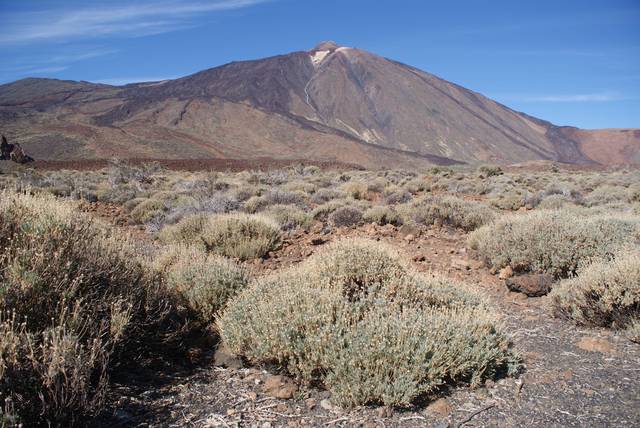 At the middle of the island, with 3,718 m, Teide is the highest mountain not just in the Canary Islands but in all Spain. The cable car goes up almost to the summit (and the summit itself just an hour of hiking away), and there are fantastic views from up there provided there are no clouds. Do get informed on the Teide article if you plan to visit (permissions, etc.).
At the middle of the island, with 3,718 m, Teide is the highest mountain not just in the Canary Islands but in all Spain. The cable car goes up almost to the summit (and the summit itself just an hour of hiking away), and there are fantastic views from up there provided there are no clouds. Do get informed on the Teide article if you plan to visit (permissions, etc.).
Cueva del Viento is one of the biggest lava cave systems in the world.
There is a botanical garden just above Puerto de la Cruz.
There are some wonderful drives all around the island. There are long winding mountain roads with breathtaking scenery but they might be challenging for less skilled drivers. Popular destination is Masca village located about 1 hour drive north of Los Gigantes (parking spaces are very limited). For those who do not rent/own a car in most resorts there are companies organizing coach trips there.
Santa Cruz de Tenerife has a number of museums and an art gallery. Also a space museum and planetarium on a small scale near La Laguna.
In February there is a huge fancy dress parade by locals which is said to be third in size after Rio and Notting Hill carnivals.
Visit the beautiful old towns of La Orotava and La Laguna, the latter being a UNESCO World Heritage Site.
One of the best spots in the world to observe sky - Teide Observatory - provides guided visits.
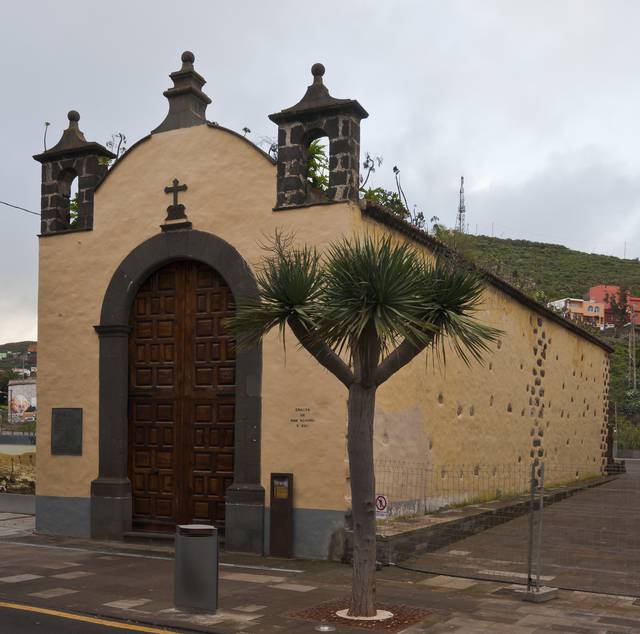 Tenerife has numerous scuba-dive operators. The seas are diveable all year, with temperatures from 18°C in January to 25°C in August. Go around the harbour wall in Puerto de la Cruz for fantastic volcanic rock formations, or feed the stringrays at Las Galletas for something a bit different.
Tenerife has numerous scuba-dive operators. The seas are diveable all year, with temperatures from 18°C in January to 25°C in August. Go around the harbour wall in Puerto de la Cruz for fantastic volcanic rock formations, or feed the stringrays at Las Galletas for something a bit different.
El Condesito is a vessel that sank near Las Galletas on the south coast of Tenerife and is now a popular dive site. The deepest point of the wreck is at 21 m and the shallowest at 6 m. Visibility can exceed 35 m. The hull, engine room and cabin used to be intact with only the bow having been torn away. Shoals of sardines may be seen at the top of the wreck, and large trumpetfish are often found around the propeller. It is not uncommon to spot barracuda, red sea stars, rays, octopus and eels within the wreck. There is a 36 m drop off nearby which is often dived by more experienced divers to see black coral before ascending to the El Condesito to decompress.
Those available include surfing, wind surfing, speed boat parashooting and jet-ski. Nowhere seems to rent canoes.
On the beach, Playa Americas is black volcanic sand but Los Cristianos is yellow imported sand. The black sand feels the same as the yellow but is not as pleasing to look at. Beaches often have sun-loungers with parasols available to hire for the day, but if you are doing this for a few days it is probably better to just buy a parasol and some beach mats.
Whale and dolphin watching trips run near Playa de las Américas.
Tenerife is an excellent destination for hiking. There are routes for anyone, from leisurely one hour strolls to extremely strenuous full day hikes in demanding terrain with either a huge ascent, descent or both. There are several books describing hiking routes, such as two Landscapes of Tenerife books from Sunflower Books, one covering the northern side and the other covering the southern side. It's a good idea to get a guide book before you go to Tenerife, as they might be difficult to find there. Another option is using openstreetmap/wikiloc as guide.
These are the most interesting hikes:
- A demanding hike up to the summit of Teide (and /or Pico Viejo) is possible.
- Closed since 2018: Probably the most popular (and somewhat crowded, compared to other Tenerife treks) path - Masca valley.. Starting at Masca village, going down all the way to a beach, in-between massive cliffs. Taking the hike uphill requires at least water supplies, in case of high temperatures.
- Barranco del Infierno. Close to Adeje popular with hikers, you need to book to go on the walk. There is little to see but vegetation on this walk and a tiny waterfall at its end.
- Punta de Teno. The most western point with excellent views. Also accessible by car via TF-445 – however as of January/2019, the road is closed Thursday to Sunday (and bank holidays), 10:00-19:00. At such times, bus 369 from Buenavista is available. On any given day, the road may be closed due to wind or rain. Of particular interest is the lighthouse, one of 7 which mark the coastline of Tenerife. The current lighthouse has 2 towers of 20 m and 8 m respectively. The beacon has a focal height of 60 m above sea level, and is solar powered..
- Bosque de Esperanza, Mirador de Ortuño. 24/7. A paradise for hikers, the Boque de Esperanza forest is both mysterious and untouched by mass tourism. Its narrow mountain roads, great hiking trails, twisted fairytale woodland landscape, and breathtaking views are worth a visit on their own. Free.
- Roque del Conde. One of the most prominent mountains on the south coast. A few hours hike from the nearby Arona village goes through a relatively big canyon of Barranco del Rey and at top provides good views to all sides (unless mist builds up)
- Anaga Rural Park (Parque Rural de Anaga) — a fantastic place to go hiking, with numerous targets.
A demanding hike up to the summit of [[Teide]] (and /or Pico Viejo) is possible.
Closed since 2018: Probably the most popular (and somewhat crowded, compared to other Tenerife treks) path - Masca valley.. Starting at Masca village, going down all the way to a beach, in-between massive cliffs. Taking the hike uphill requires at least water supplies, in case of high temperatures.
Barranco del Infierno. Close to Adeje popular with hikers, you need to book to go on the walk. There is little to see but vegetation on this walk and a tiny waterfall at its end.
Punta de Teno. The most western point with excellent views. Also accessible by car via TF-445 – however as of January/2019, the road is closed Thursday to Sunday (and bank holidays), 10:00-19:00. At such times, bus 369 from [[Buenavista]] is available. On any given day, the road may be closed due to wind or rain. Of particular interest is the lighthouse, one of 7 which mark the coastline of Tenerife. The current lighthouse has 2 towers of 20 m and 8 m respectively. The beacon has a focal height of 60 m above sea level, and is solar powered..
Bosque de Esperanza, Mirador de Ortuño. 24/7. A paradise for hikers, the Boque de Esperanza forest is both mysterious and untouched by mass tourism. Its narrow mountain roads, great hiking trails, twisted fairytale woodland landscape, and breathtaking views are worth a visit on their own. Free.
Roque del Conde. One of the most prominent mountains on the south coast. A few hours hike from the nearby Arona village goes through a relatively big canyon of Barranco del Rey and at top provides good views to all sides (unless mist builds up)
Tenerife attracts a large number of cyclists all year around. Whether mountain biking or road biking, Tenerife has plenty of beautiful roads and dirt tracks. If you want to avoid the hassle of bringing your own bike, you can rent bikes on the island, for example in Las Americas or El Médano.
Cycling is hard to do casually although bikes are available to rent, the coastal roads are busy and there is little room for bikes except often in the gutter. However if you like cycling up hills there are plenty of steep roads to climb as soon as you leave the coastline. For those less fit, one tour company offers a car trip to the top of El Teide with a cycle down, no pedalling required.
There are good attraction parks.
- Loro Parque Zoo — a large animal park famous for its parrots and orca shows.
- Jungle Park — well worth a visit, the bird of prey show is a must.
- Siam park — opened in 2008, this is a fantastic water park, created by the owners of Loro Parque - and it has been beautifully designed, like a modern Lago Martianez! Look out for the 2 metre high artificial waves.
- Aqualand — a water park.
[[Puerto de la Cruz#Loro Parque|Loro Parque Zoo]] — a large animal park famous for its parrots and orca shows.
[[Los Cristianos#Jungle Park|Jungle Park]] — well worth a visit, the bird of prey show is a must.
[[Los Cristianos#Siam park|Siam park]] — opened in 2008, this is a fantastic water park, created by the owners of Loro Parque - and it has been beautifully designed, like a modern Lago Martianez! Look out for the 2 metre high artificial waves.
[[Los Cristianos#Aqualand|Aqualand]] — a water park.
Santa Cruz has a big market by the station on Sunday mornings, and a local picturesque market Mercado Municipal Nuestra Señora de África (open daily until 14:30). Las Americas has one Thursdays and Saturdays and Los Cristianos on Sundays and Tuesdays.
Keep in mind that almost all goods with the exception of fish and fruits must be imported, so buying clothes or electronics is neither economical nor ecological. In addition, the quality of hardware such as cameras and binoculars sold in gift/souvenir shops or by street vendors is questionable.
Local taverns are called guachinches, typical for the Canarias and particularly common on Tenerife and Gran Canaria. They serve their own wine accompanied by homemade traditional food, often grilled fish or roasted meat. Stews of all kinds are very common and only cost a few euros for a portion. This blog keeps an overview of the best guachinches on the island.
Fish is a large part of the local diet with restaurants that allow you to choose a fish from their selection (often hand caught) which they will cook for you. Black potatoes called Papas arrugadas are served unpeeled, wrinkled and crusted with salt ready to be dipped into a local sauce.
As in the rest of Spain, tapas are eaten a lot with local specialties including garlic sauces, fried beans and squid. Typical Spanish meals such as tortilla (potato omelette) and paella (rice dishes) are common too.
Fast food is becoming increasingly common on Tenerife, catering to younger demographics and tourists. Restaurants with international cuisine (Indian, Chinese, ...) are abundant in larger cities. Especially in the south of the island, there are plenty of restaurants serving exotic foods such as hamburgers, pizza, fries, etc. There are 15 McDonald's including some on the beaches. In touristic hotspots such as Playa de las Américas, menus are available in numerous languages ranging from English and German to Russian and some Scandinavian languages, making it very easy to choose even if you are not familiar with the local dishes' names or don't understand Spanish.
The nicest bars are found in Puerto de la Cruz, La Laguna, and in the capital Santa Cruz de Tenerife. They serve a wide variety of locally produced beers, wines, and liqueurs. The best wines also originate from the north of the island, where cultivation of the malvasia grape variety has a long tradition since export began in the 17th century. 50% of Canary wine denominations originate from Tenerife. In addition, countless wines are produced in house by guachinches in small quantities, often as mixtures of red wines with fruity wines.
Beers produced on the island are also widely available, most notably Dorada (gold) and Reine (queen), although their taste is not particularly special. Because of the size constraints (arable land) on the island, the entire production is consumed domestically, so you won't find these beers anywhere else.
The abundance of fruits also yields a variety of liqueurs and other drinks with high alcoholic content, most notably banana liqueurs.
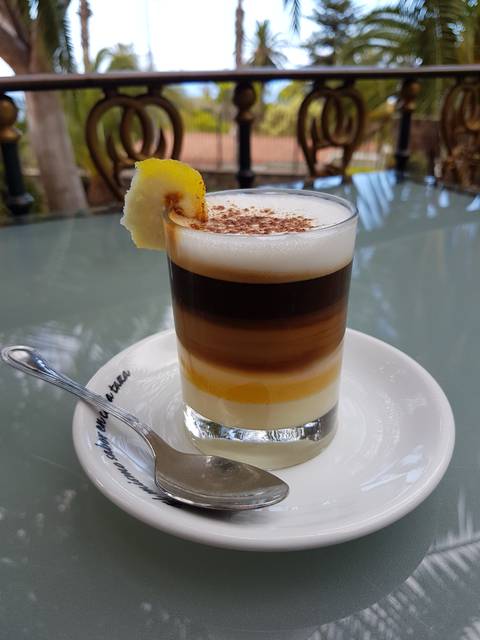 The coffee Barraquito (also called barraco) is a Canary specialty and very popular on Tenerife and on La Palma. It is served in a small glass, with a base of condensed milk, espresso, and a shot of Licor 43 (Cuarenta Y Tres). It is often served after the meal, finished with cinnamon and lime zest.
The coffee Barraquito (also called barraco) is a Canary specialty and very popular on Tenerife and on La Palma. It is served in a small glass, with a base of condensed milk, espresso, and a shot of Licor 43 (Cuarenta Y Tres). It is often served after the meal, finished with cinnamon and lime zest.
The south of Tenerife has a 'booze scene' reputation, with Playa de las Américas and Los Cristianos providing ample locations for those that enjoy 24 hour clubbing and drinking, with clubs charging between €10 and €25 entrance. The drinks available are the same as the rest of Europe (predominantly British) with prices being slightly less than those of continental Europe. Better alternatives are found in the north of the island, especially in La Laguna, where there are no entrance fees and drinks have a higher price/quality ratio.
Tenerife is generally a safe place to visit but as always, beware of pickpockets. Do not take electrical devices, credit cards or large amounts of cash to the beach if you plan to leave your goods unattended while swimming. Walking alone late at night in certain suburbs is not advisable, although the inner parts of town aren't problematic. Take note that when walking through Playas De Las Americas there is a lot of clubs round here and some drunkenness in the night hours. Taxis are widely available, and not too badly priced.
Camping and sleeping at the beach is only permitted at allowed zones. Doing so in frequented beaches may lead to arrest.
Many, many shops on the island selling electrical and optical goods as well as cameras. You may think you are getting a bargain from these smooth talking salesmen but you aren't. You will overpay for something you could buy cheaper at home and even cheaper off eBay. Your goods may be faulty. Your guarantee will probably be worthless. Your video camera may be SECAM which means a B&W picture in the UK (PAL). These shops are everywhere in the tourist areas and so many people have been cheated by them for so many years. Also, beware of places that sell video games (mainly for the Nintendo Game Boy or DS) as they are usually bootlegs.
If you are holidaying in Tenerife you are probably going to be approached by "scratchcard touts" whose main aim is to part you with several thousand pounds for worthless contracts for time-share apartments. This view is backed up by the UK's Office of Fair Trading who suggest that every year 400,000 UK consumers fall victim to these scams in destinations such as Tenerife, the Costa del Sol and Gran Canaria. On average each victim loses more than £3,000. Bogus "scratchcard touts" offer cards that will always be a winner, but to collect their prize, people need to attend a lengthy presentation and are persuaded into signing a contract for an "exclusive" club on the basis of false claims as to the price, range and quality of holidays available. The OFT's is advising people to ask three simple questions: can you take away the contract to consider at your leisure? Is everything you were promised in the presentation in the contract? Do you know exactly what you are getting for your money? If the answer to any of these questions is no, then simply walk away.
The other main irritant on Tenerife are the Lookey Lookey men who try to sell you sunglasses, watches, jewellery and other cheap knick-knacks known as Lucky Luckies. They are quite harmless and generally don´t mean to cause trouble, they are just trying to make a living, but a firm NO generally works!
Tenerife is a volcanic island. The latest outbreak was 1909 from the El Chinyero vent in the northwest part of El Teide. On geologic time scales this is very recent, and although El Teide is dormant, it is still considered to be an active volcano. However, it is constantly monitored very closely so that an upcoming eruption would hopefully be detected well in advance.
Falling rocks are a constant issue in many parts of the island, and you will often find paths, beaches or even roads temporarily or permanently closed due to the danger.
The sun is extremely strong this close to the equator so use plenty of high factor sun cream and do not sun bathe between midday and three o'clock (this is when the beaches are busiest anyway). Remember that the sun is even stronger up in the mountains, even though it may feel cool and breezy.
There are no scorpions or snakes to worry about. Mosquitoes can bite at night, especially away from the coast, but they do not carry malaria or similar diseases.
- La Gomera - a hiking paradise - is only 1 hour away by ferry.
- Gran Canaria island is 2.5 hours by ferry.
- La Palma and El Hierro islands are also accessible by ferry.
[[La Gomera]] - a hiking paradise - is only 1 hour away by ferry.
[[Gran Canaria]] island is 2.5 hours by ferry.
[[La Palma]] and [[El Hierro]] islands are also accessible by ferry.
